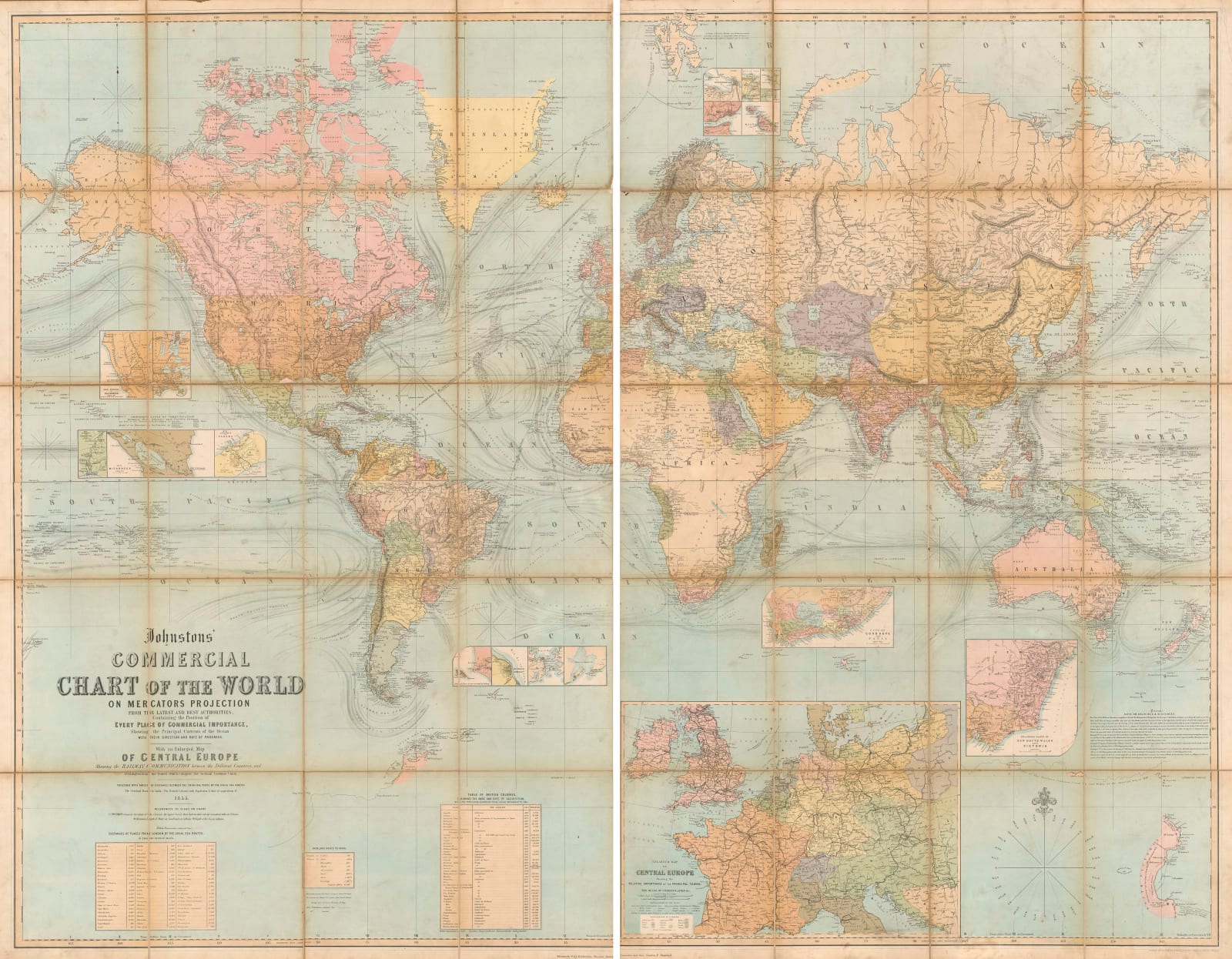All Maps
Our entire inventory of over 10,000 antique and vintage maps is now available to browse by region, date, cartographer, and subject
W. & A.K. Johnston
Commercial Chart of the World, 1855
55 ½ x 71 ½ in
141 x 182 cm
141 x 182 cm
WLD4857
Further images
A magnificent folding wall map of the world with insets of British Empire territories and areas of commercial importance, such as the gold regions of California, New York Harbour, and...
A magnificent folding wall map of the world with insets of British Empire territories and areas of commercial importance, such as the gold regions of California, New York Harbour, and possible locations for a canal across Panama or Nicaragua.
Alexander Keith Johnston and his brother William were at the forefront of Scottish cartography for much of the 19th century. Trained by the firm of Kirkwood and later W.H. Lizars, they set up their own business in 1826 and for the next fifty years dominated their field. The firm particularly focused on thematic mapping, especially related to zoology, biology, geology, orography, and the fledgling science of climatology. In 1848 the firm published "The Physical Atlas", a work which focused on the geographical sciences of the natural world. It was the first atlas to its kind in the United Kingdom and was highly successful, with an enlarged edition being issued in 1856.
This large segmented folding wall map of the world is very unusual amongst the firm's products. Unlike many of their contemporary cartographer, the Johnston firm issued relatively few folding maps under their own imprint. They are credited on many of Edward Stanford's glorious Library Maps, so wall maps certainly were not beyond their scope, but for some reason they rarely produced and sold these large maps themselves. Perhaps they felt they did not have the right customer base for maps of such grandeur, or perhaps the costs of production could not be justified. Either way, the traditions which the Johnston firm established in their atlas maps are readily apparent in the clarity of this map's engraving, the high level of scholarship involved, and the focus on a specific theme, in this case commerce.
An extensive network of shipping routes is shown on the map. Each is labelled with the port of departure and port of arrival, together with distances and time taken between destinations. Proposed steamship routes are marked with dotted lines. Complementing the marine routes is a growing railway network, mainly in Europe and North America. A large inset map focuses on Central Europe, with a particular interest in the extent of the German Customs Union, or Zollverein, established by Prussia in 1834. A table of British colonies states the date of acquisition by Britain, the method of acquisition, and the current population size. Another table lists the stages in the overland route from London to Mumbai.
While it is not its primary intention, the map is largely up to date geo-politically. A small note on the key on the lower left notes that the areas which were part of the British Empire are outlined in pink/red, the Empire's traditional colour scheme. The interior of Africa remains largely unexplored as this map pre-dates the expeditions of Speke, Burton, Grant, Livingstone, and Stanley. The faintest outlines of Antarctica have started to appear along the bottom of the map, with the exception of Victoria Land which was discovered by James Clark Ross in 1841 and appears in much greater detail. The southern border between Mexico and the United States remains unresolved - the Gadsden Purchase had been concluded in 1854, but those details have not made it onto this map. In South America, Bolivia still has its Pacific coastline, Patagonia is not yet considered part of Chile or Argentina, and Panama is united with Colombia. In Australia, several proposed, but unused, province names appear, including Cooks Land, Flinders Land, and Leicharts Land in place of Queensland.
Folded in two parts, east and west. Printed colour. [WLD4857]
Alexander Keith Johnston and his brother William were at the forefront of Scottish cartography for much of the 19th century. Trained by the firm of Kirkwood and later W.H. Lizars, they set up their own business in 1826 and for the next fifty years dominated their field. The firm particularly focused on thematic mapping, especially related to zoology, biology, geology, orography, and the fledgling science of climatology. In 1848 the firm published "The Physical Atlas", a work which focused on the geographical sciences of the natural world. It was the first atlas to its kind in the United Kingdom and was highly successful, with an enlarged edition being issued in 1856.
This large segmented folding wall map of the world is very unusual amongst the firm's products. Unlike many of their contemporary cartographer, the Johnston firm issued relatively few folding maps under their own imprint. They are credited on many of Edward Stanford's glorious Library Maps, so wall maps certainly were not beyond their scope, but for some reason they rarely produced and sold these large maps themselves. Perhaps they felt they did not have the right customer base for maps of such grandeur, or perhaps the costs of production could not be justified. Either way, the traditions which the Johnston firm established in their atlas maps are readily apparent in the clarity of this map's engraving, the high level of scholarship involved, and the focus on a specific theme, in this case commerce.
An extensive network of shipping routes is shown on the map. Each is labelled with the port of departure and port of arrival, together with distances and time taken between destinations. Proposed steamship routes are marked with dotted lines. Complementing the marine routes is a growing railway network, mainly in Europe and North America. A large inset map focuses on Central Europe, with a particular interest in the extent of the German Customs Union, or Zollverein, established by Prussia in 1834. A table of British colonies states the date of acquisition by Britain, the method of acquisition, and the current population size. Another table lists the stages in the overland route from London to Mumbai.
While it is not its primary intention, the map is largely up to date geo-politically. A small note on the key on the lower left notes that the areas which were part of the British Empire are outlined in pink/red, the Empire's traditional colour scheme. The interior of Africa remains largely unexplored as this map pre-dates the expeditions of Speke, Burton, Grant, Livingstone, and Stanley. The faintest outlines of Antarctica have started to appear along the bottom of the map, with the exception of Victoria Land which was discovered by James Clark Ross in 1841 and appears in much greater detail. The southern border between Mexico and the United States remains unresolved - the Gadsden Purchase had been concluded in 1854, but those details have not made it onto this map. In South America, Bolivia still has its Pacific coastline, Patagonia is not yet considered part of Chile or Argentina, and Panama is united with Colombia. In Australia, several proposed, but unused, province names appear, including Cooks Land, Flinders Land, and Leicharts Land in place of Queensland.
Folded in two parts, east and west. Printed colour. [WLD4857]
Join our mailing list
* denotes required fields
We will process the personal data you have supplied to communicate with you in accordance with our Privacy Policy. You can unsubscribe or change your preferences at any time by clicking the link in our emails.







